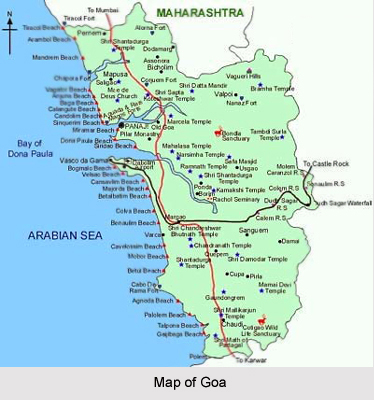 Goa is situated on the west coast of India in the region of the Konkan, which is an escarpment rising up to the Western Ghats that separates it from the Deccan Plateau.
Goa is surrounded on the north by Maharashtra, to the east and south by Karnataka and at the western coast by Arabian Sea. Goa is one of India`s smallest states with an area of 3,702 sq km is and is enclosed in the Sahayadri range in the Western Ghats. Goa lies between the latitudes 14°53`54" N and 15°40`00" N and longitudes 73°40`33" E and 74°20`13" E. Goa has a coastline of 63 miles. Goa is a part of Konkan area. Goa has hills, low and highland areas.
Goa is situated on the west coast of India in the region of the Konkan, which is an escarpment rising up to the Western Ghats that separates it from the Deccan Plateau.
Goa is surrounded on the north by Maharashtra, to the east and south by Karnataka and at the western coast by Arabian Sea. Goa is one of India`s smallest states with an area of 3,702 sq km is and is enclosed in the Sahayadri range in the Western Ghats. Goa lies between the latitudes 14°53`54" N and 15°40`00" N and longitudes 73°40`33" E and 74°20`13" E. Goa has a coastline of 63 miles. Goa is a part of Konkan area. Goa has hills, low and highland areas.
Geographically Goa has mainly three natural divisions namely :
•The Low lands
•The Plateaus
•The Mountain region
The main rivers of Goa are Mandovi, Zuari, Terekhol, Chapora and the Betul. Goa has more than forty estuarine, eight marine and about ninety riverine islands. Goa`s soil cover is made up of laterites that are composed of rich ferric aluminium oxides. The soil is red in color because of the presence of iron in it. Along the river banks the soil appears to be alluvial and loamy.
Goa experiences a warm and humid climate. Goa has 3 seasons as:
•Summer- The month of May is the hottest and has a temperature of 35°C. There is high humidity.
•Winter In the mid-December and February Goa experiences a short cool season. During these months there are cool nights and warm days with moderate humidity.
•Monsoon- the monsoon rains arrive by early June which is a source of relief for the people. The monsoon lasts till late September.



















